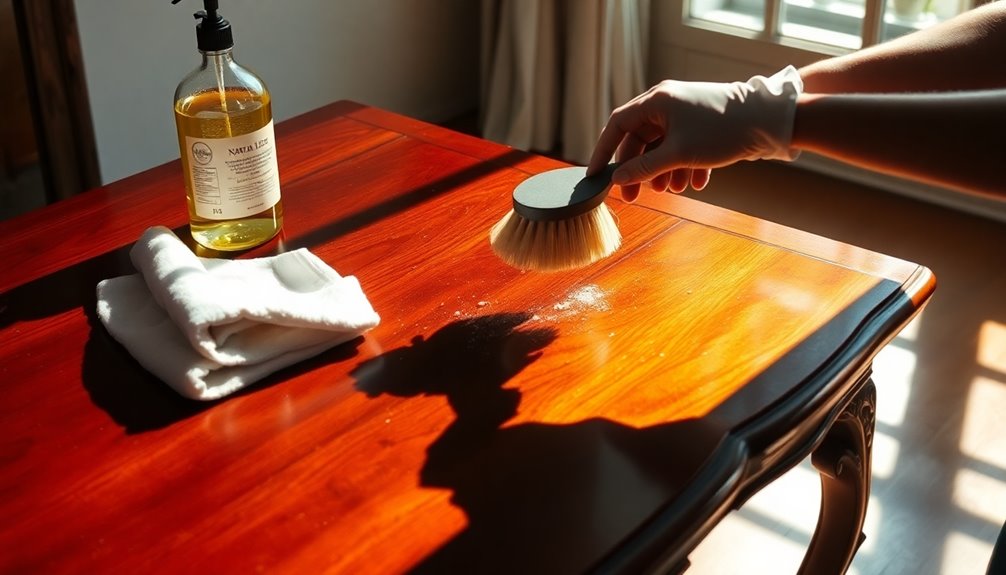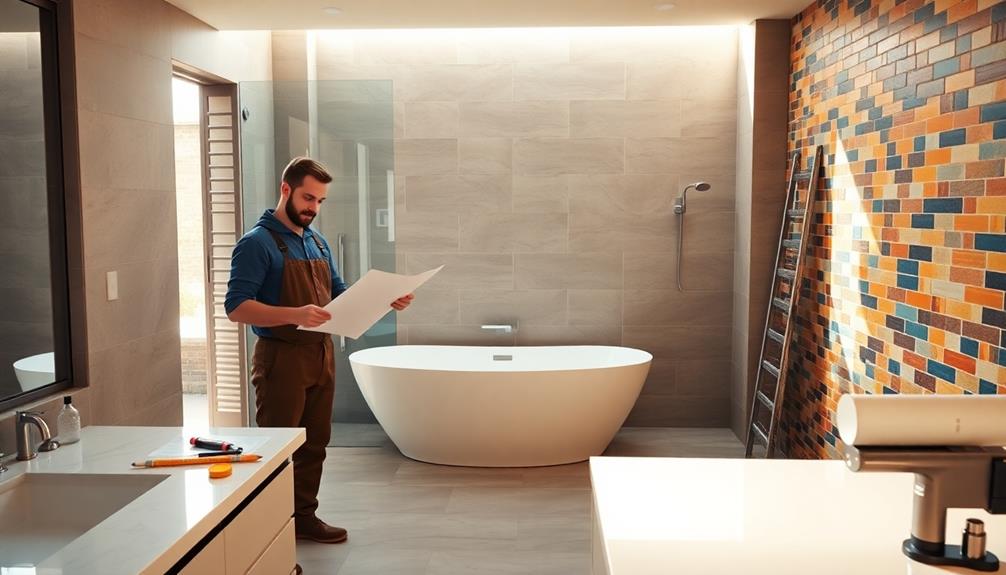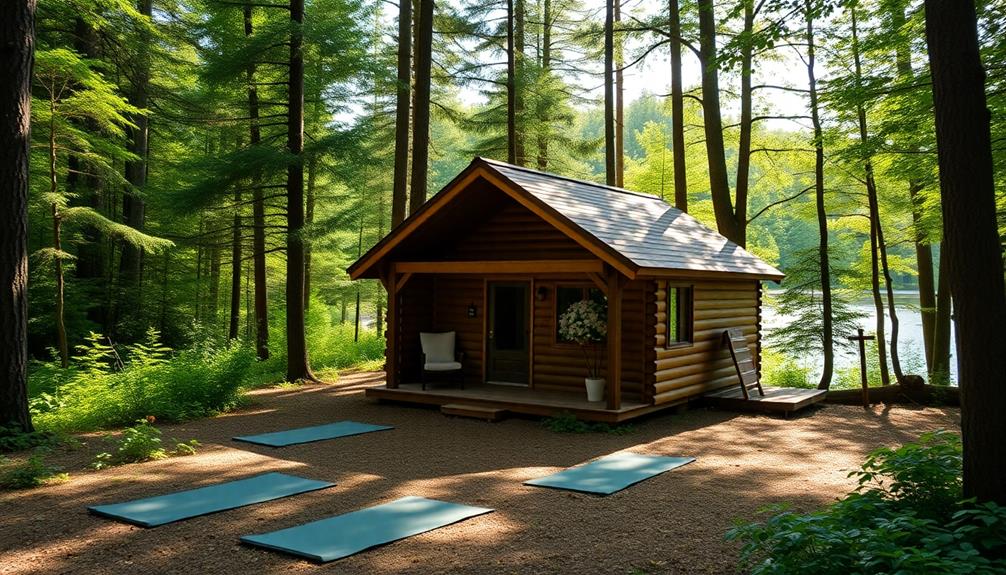To clean your wooden furniture, start by removing any decor and vacuuming nearby areas to eliminate dust. Use a microfiber cloth for initial dusting, focusing on corners and crevices. For a gentle clean, mix mild dish soap with warm water or equal parts white vinegar and water. Apply with a damp cloth, wringing it out to avoid excess moisture. For extra shine, use a lemon juice and olive oil paste. Remember to polish regularly and control humidity levels to prevent damage. By following these tips, you can ensure your furniture stays beautiful and lasts longer—there's plenty more helpful advice ahead!
Key Takeaways
- Start by removing decor and vacuuming to eliminate dust before cleaning wooden furniture.
- Use a mild soap and water solution or equal parts vinegar and water for effective cleaning.
- Test cleaning solutions on hidden areas to prevent damage to the wood finish.
- Dry surfaces thoroughly and maintain optimal humidity levels to protect wood integrity.
- Regularly dust and polish with a soft cloth to maintain shine and prevent surface damage.
Preparation and Initial Cleaning

Before you begin cleaning your wooden furniture, it's crucial to prepare the area properly. Start by removing all decor, cushions, and rugs to clear your working space and prevent scratches. Take off any objects like lamps and pillows, then pull the furniture away from the wall to access all sides. If there's any non-essential hardware, unscrew and remove it to make cleaning easier. Next, vacuum the area around the furniture to reduce dust and debris.
Once your area's prepped, it's time for initial cleaning. Use a microfiber cloth, feather duster, or vacuum with a brush nozzle to remove dust and loose dirt. If you don't have a vacuum handy, lightly moisten a cloth to wipe down the wood. Be sure to focus on crevices and corners where dust tends to gather, using a soft brush for intricate details and carvings. Teak wood, known for its durability outdoors, may require special attention if used in exterior settings. Ensure all surfaces are free from debris before you apply any cleaning solution. This preparation sets the stage for a successful cleaning session, ensuring your wooden furniture looks its best while remaining protected during the process.
Effective Cleaning Solutions
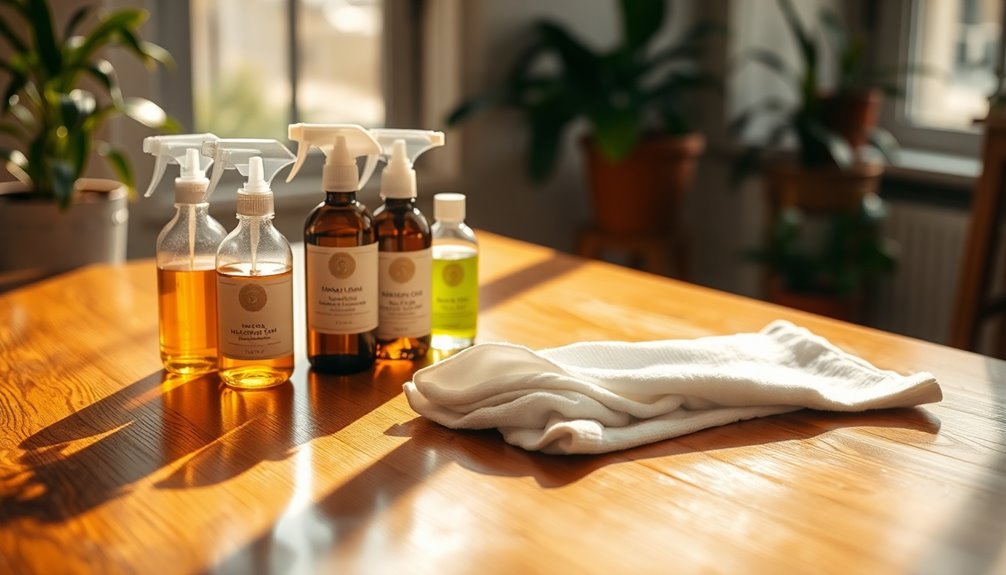
There are several effective cleaning solutions you can use to maintain your wooden furniture. For a gentle cleanse, mix mild dish soap with warm water. This solution is safe for most sealed finishes. If you need to tackle dirt and grime, combine equal parts white vinegar and water; it's perfect for removing water spots and sticky residues.
For a nourishing and disinfecting option, try mixing equal parts lemon juice and olive oil to create a paste that adds a natural shine. For stubborn stains, a paste of baking soda and water works wonders—apply it, let it sit, and then wipe off with a damp cloth.
If you prefer commercial products, consider Weiman Wood Furniture Cleaner & Polish, which cleans and protects without leaving a messy buildup. It is formulated with four nourishing oils that beautify and protect your furniture while enhancing its natural luster. TriNova Wood Cleaner & Conditioner is another option that effectively deals with fingerprints and food residue.
Remember to avoid harsh chemicals, as they can damage your furniture's finish. Using these effective solutions will help keep your wooden furniture looking its best while preserving its integrity.
Application Techniques
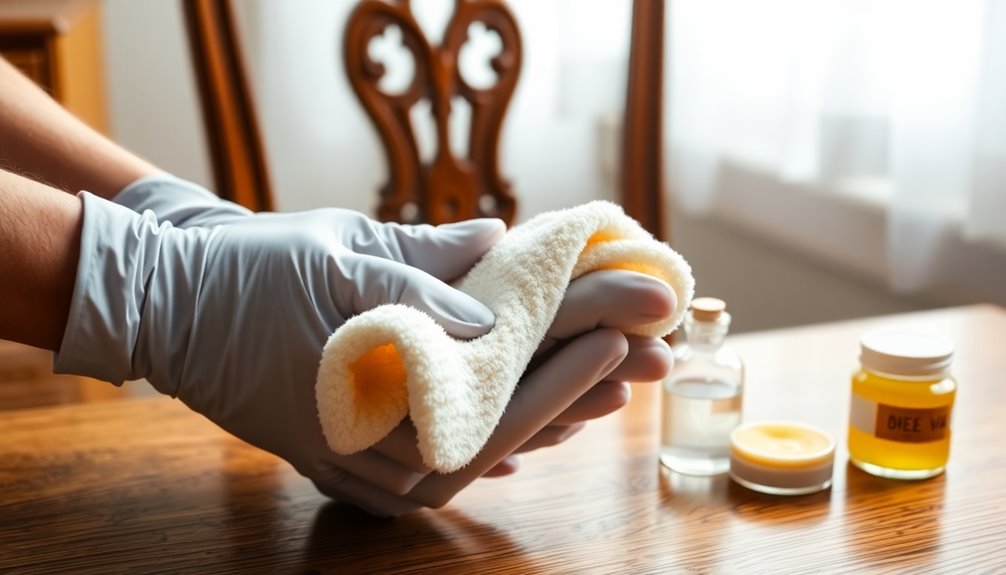
To effectively clean your wooden furniture, start by preparing the surface properly. Use a microfiber cloth to dust off any loose debris, and for furniture with carvings or grooves, grab a soft-bristle brush to reach those tight spaces. Before you begin, remove any decor, cushions, and rugs to avoid scratches and ensure a clear working area. Always test your cleaning solution on a small, hidden area to prevent damage to the finish.
Next, mix a mild dish soap or white vinegar with warm water to create a cleaning solution. Dip a soft cloth into the solution, wring it out until it’s barely damp, and gently wipe the furniture. Cover all surfaces, paying special attention to crevices. For stubborn stains, consider using mineral spirits. Regular care preserves the appearance and structural integrity of wood furniture. After cleaning, ensure the furniture is dried thoroughly to prevent moisture damage. To further protect your pieces, consider applying a wood conditioner or polish that is suitable for your specific type of wood. If you’re wondering how to maintain white furniture, using a protective cover or slipcover can help keep it looking fresh while minimizing the frequency of deep cleaning.
If you encounter specific stains, dab non-gel toothpaste on water stains, or create a paste with baking soda and water for heat stains. For ink, use rubbing alcohol on a cotton ball. For sticky residue, mix equal parts white vinegar and water, and gently rub with a damp cloth. This thorough approach ensures your wooden furniture remains clean and well-maintained.
Drying and Moisture Control
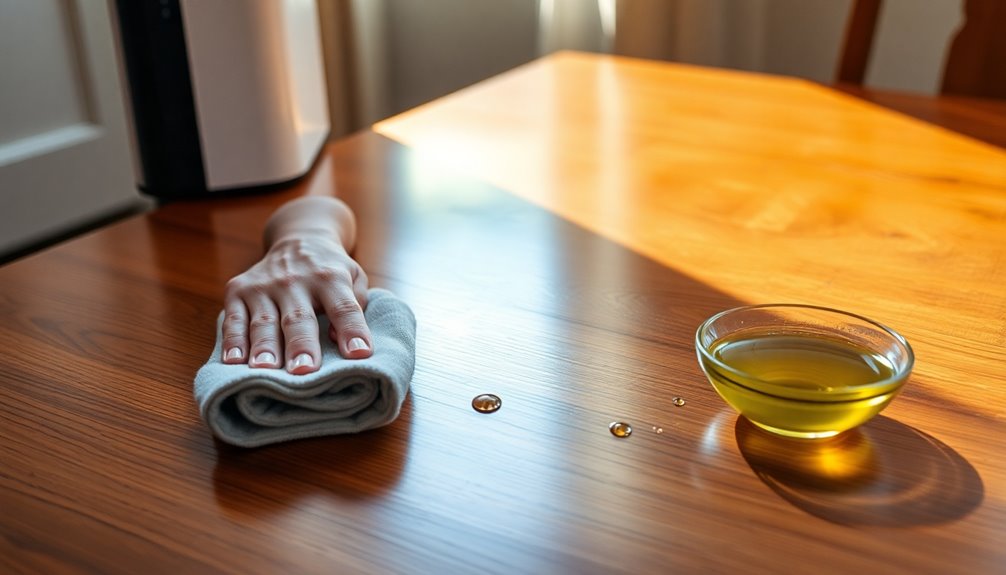
Proper drying and moisture control are essential for maintaining the beauty and integrity of your wooden furniture. To start, aim for a moisture content of 6% to 12% for optimal results. Harvest your logs in late fall or winter when sap levels are lower, and remove the bark to prevent moisture trapping. Sealing the ends with a commercial wood sealer or a wax and paint mixture helps minimize excessive moisture loss.
When stacking the logs, ensure they're in a well-ventilated area with spacers between them to promote air circulation. Elevate the bottom layer to avoid moisture contact with the ground. It's crucial to monitor humidity levels, keeping them between 40% and 60% for preservation. Proper seasoning is critical as it prevents warping, cracking, and shrinking in your wooden furniture.
Use a hygrometer to track indoor humidity, and consider humidifiers in dry climates or winter months to maintain necessary moisture. Conversely, employ dehumidifiers during humid seasons to remove excess moisture. Remember, avoiding extreme humidity fluctuations is vital to prevent wood from swelling, shrinking, or cracking. By following these steps, you can effectively manage drying and moisture control, ensuring your wooden furniture remains in excellent condition.
Polishing and Protection
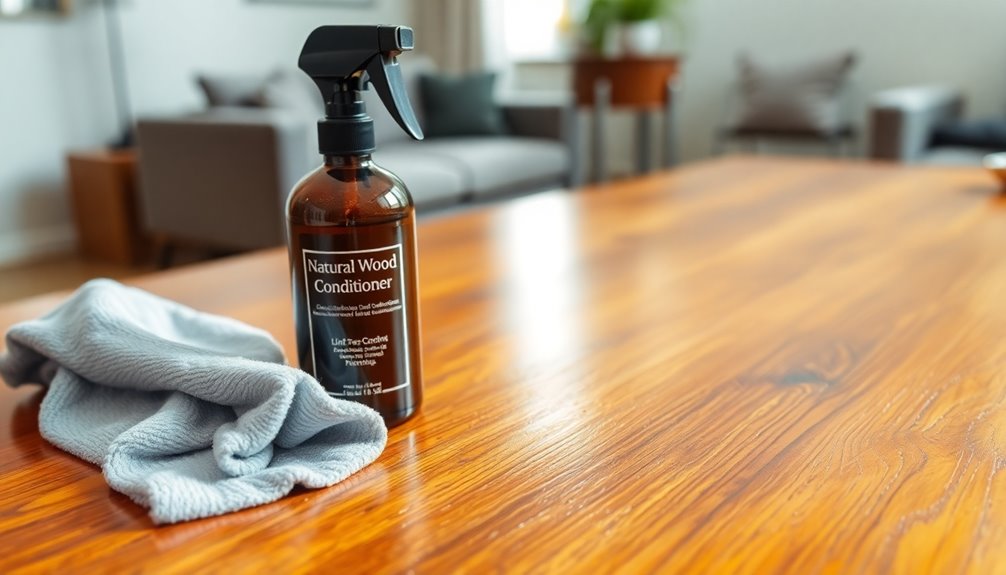
Maintaining your wooden furniture's appearance goes beyond just managing moisture levels; polishing and protection play a vital role too. Start by applying wood polish with a small amount on a soft, lint-free cloth made of cotton or microfiber. Always apply the polish in the direction of the wood grain to prevent scratches and ensure even coverage. Work in small sections for better control, and avoid overapplying to prevent a sticky residue.
When applying, use long, straight strokes with light to moderate pressure, following the natural pattern of the wood's growth rings. This technique enhances the wood's beauty and prevents swirl marks. After applying the polish, buff the surface with a clean cloth, using circular motions and moderate pressure. Focus on one area at a time, and check for streaks or unevenness as you go.
Consider using protective finishes like furniture polish or wax for added protection and luster. Regularly apply wood oil or conditioner for unsealed furniture to maintain its shine. Aim to polish every few months to guard against scratches and daily wear, keeping your wooden furniture looking its best. Additionally, regular dusting (at least once a week) helps remove debris and enhances the overall cleanliness of your furniture.
Special Cases for Stains
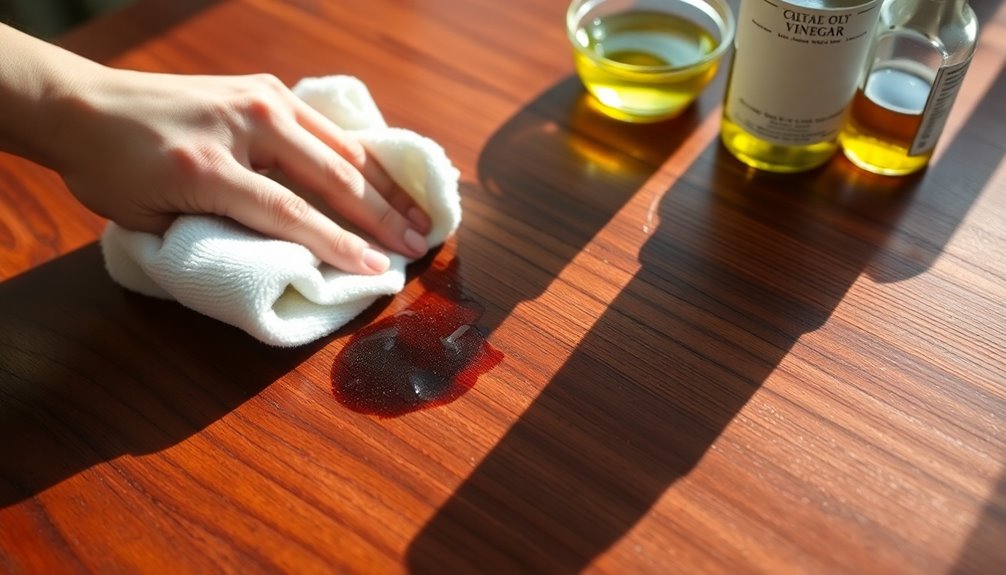
When it comes to tackling stains on wooden furniture, knowing the right approach can make all the difference. For water stains, try soaking paper towels in white vinegar and placing them on the stain for about 30-45 minutes. Alternatively, mix baking soda with distilled vinegar to create a paste and apply it directly. If you're dealing with oil and grease stains, mayonnaise works wonders; just apply it, let it sit for a few hours, and wipe it off. Petroleum jelly is another effective option.
Ink and dye stains require a more delicate touch. Lightly dampen a cloth with hydrogen peroxide and apply it to the stain, letting it sit overnight. You can also mix baking soda with non-gel toothpaste for another paste solution. For dark and old stains, consider using CitriStrip gel; cover it with plastic wrap, wait up to an hour, then scrub it off. If the stain persists, gently sand the area once it's dry. Always remember to follow up with a protective finish like Polycrylic to keep your wood looking its best. Additionally, after using CitriStrip gel, make sure to clean the surface thoroughly with soap and water to remove any residue before applying a protective finish.
Tips for Maintaining Wood
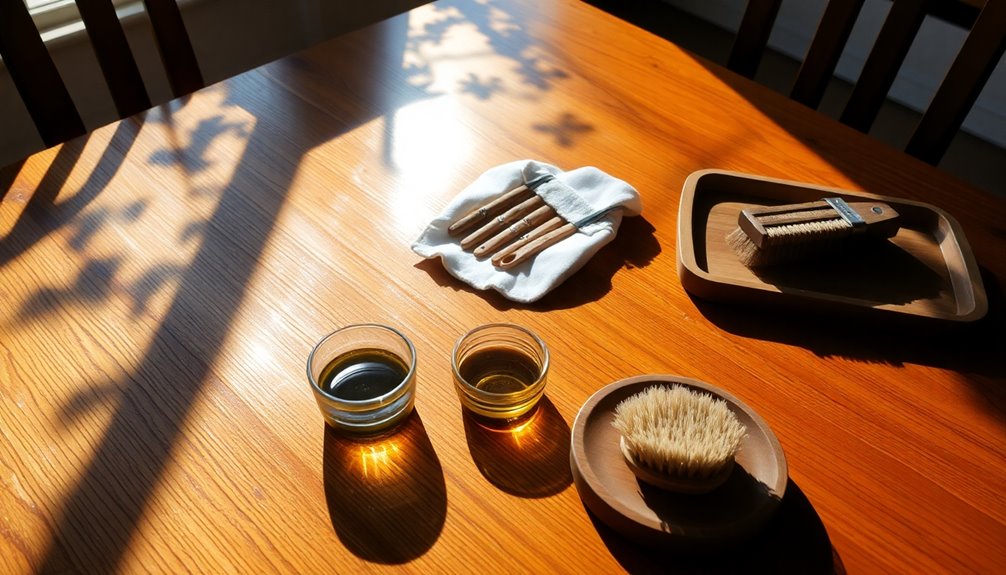
After addressing stains effectively, keeping your wooden furniture in top shape requires regular maintenance. Start by dusting your furniture regularly with a soft, lint-free cloth, always moving in the direction of the wood grain to avoid scratches. For deeper cleaning, dampen the cloth with a mild dish soap solution, rinse with soap-free water, and dry the surface immediately. Steer clear of harsh cleaners that can strip the wood's natural oils.
To protect your furniture from environmental factors, keep it out of direct sunlight and use curtains to filter UV rays. Maintaining stable temperature and humidity levels in your home is crucial; consider using a humidifier or dehumidifier as needed. Additionally, solid wood furniture is known for its durability against wear and tear, making it a practical choice for any home. Regularly checking and adjusting temperature and humidity levels can further enhance the longevity of your wooden pieces.
Prevent surface damage by using coasters and placemats for hot or wet items, and place felt pads under decorative objects to avoid scratches. When moving furniture, lift it instead of dragging to prevent dents. Lastly, apply furniture polish sparingly and choose one low in alcohol to maintain the finish. By following these tips, you can ensure your wooden furniture remains beautiful and durable for years to come.
Final Thoughts on Care
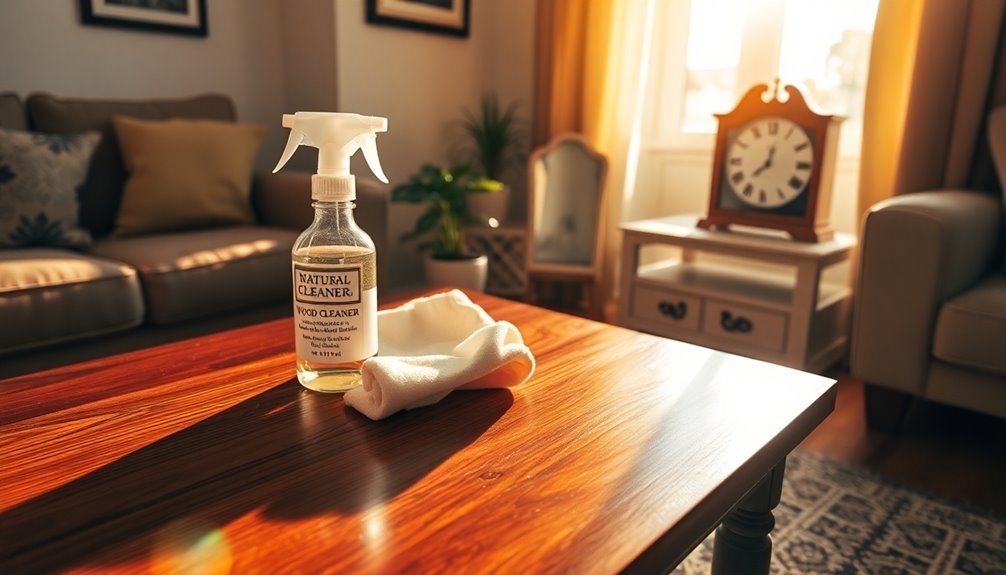
Caring for your wooden furniture not only preserves its beauty but also extends its lifespan. Regular cleaning is essential; dust daily with a soft microfiber cloth and use a damp cloth weekly to tackle smudges and light dirt. Monthly polishing with high-quality wood polish enhances the wood's natural charm and offers protection. For deeper cleaning, dilute mild dish soap or white vinegar, but steer clear of harsh chemicals that could harm the finish.
Protect your furniture by using coasters and trivets to prevent water marks and heat damage. Place protective pads under heavy items and keep furniture away from direct sunlight and heat sources. Maintaining humidity levels between 35% and 45% also helps prevent warping, as control humidity levels is essential for preventing damage.
Inspect your furniture periodically for wear and tear. Tighten loose screws and address scratches promptly. When tackling repairs, test methods on inconspicuous areas first.
Finally, adapt your care routine to seasonal changes and the type of wood finish you have. By following these strategies, you'll ensure that your wooden furniture not only looks great but lasts for generations to come.
Frequently Asked Questions
Can I Use Essential Oils on Wooden Furniture?
Yes, you can use essential oils on wooden furniture! They offer natural benefits like antibacterial properties and a lovely scent. Just make sure to dilute them with a carrier oil to avoid damaging the wood. Conduct a patch test on a small area first, and use a soft cloth for application. Regularly applying essential oils can enhance the wood's appearance and protect it from environmental damage. Enjoy a refreshed, aromatic space!
How Often Should I Clean My Wooden Furniture?
You should clean your wooden furniture every couple of weeks to keep it looking its best. If you've got pets or a busy household, consider doing it once a month instead. Regular dusting's important too; aim for at least once a week to prevent dirt buildup. This simple routine helps maintain the furniture's appearance and durability, ensuring it stays beautiful and functional for years to come. Don't forget to check for any necessary repairs!
Is It Safe to Use a Vacuum on Wood Surfaces?
It's not always safe to use a vacuum on wood surfaces. Regular vacuums can scratch or dent your floors due to rigid brush rollers and plastic wheels. To protect your wood, opt for a vacuum designed for hard surfaces, preferably a canister model with gentle suction. Always check that the vacuum is suitable for your specific wood type, and consider using a brush attachment to minimize damage while keeping your spaces dust-free.
What Types of Wood Furniture Require Special Care?
When it comes to wood furniture requiring special care, you'll want to pay attention to exotic woods like teak, rosewood, and ebony. These types need regular oiling and gentle cleaning to maintain their natural beauty. Hardwoods like oak and cherry also need careful treatment, but they're generally more durable. Avoid harsh chemicals and direct heat, as they can damage finishes and the wood itself. Being proactive will help preserve the furniture's integrity.
Can I Use Furniture Polish on Antique Wood?
You can use furniture polish on antique wood, but be cautious. Always choose a natural polish to avoid harsh chemicals that might damage the finish. Test it on a small, hidden area first to ensure it doesn't react negatively. Apply it sparingly and buff in the direction of the grain. Regular maintenance is key, so keep your antique pieces clean and protected from direct sunlight and heat to preserve their beauty.
Conclusion
Taking care of your wooden furniture doesn't have to be complicated. By preparing properly, using the right cleaning solutions, and applying them with care, you can keep your pieces looking their best. Don't forget to dry them thoroughly and apply polish for added protection. For any stubborn stains, address them promptly. With a little regular maintenance, your wooden furniture will remain beautiful and last for years. Enjoy the warmth and character it brings to your home!
